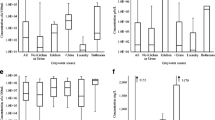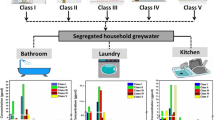Abstract
Greywater from baths, showers and washbasins was collected separately from all other domestic wastewater at a university block of flats with a dual reticulation system and analysed for a range of contaminants including indicator organisms and pathogens. Greywater flow and temperature were also monitored and a diurnal variation was observed. Physical and chemical water quality parameters were similar to previously published data, although measured COD and BOD levels appeared to be lower, possibly due to settlement or biodegradation in the storage tanks. Plate counts and indicator organism concentrations were consistently high suggesting a high level of human bacterial contamination necessitating biological treatment and disinfection if the water is to be used for recycling. However, these high levels of indicator organisms did not correlate to pathogen presence and should not be used as pathogen indicators in greywater. One positive count of Salmonella veltereden was observed as well as low levels of Giardia. Cryptosporidium, Escherichia coli O157:H7, enteroviruses and Legionella were not identified in any of the samples. The research also highlighted a number of problems with the complexity of this type of sampling programme, such as identifying the most likely time to isolate pathogens and analysing an ‘unusual’ water source.
Similar content being viewed by others
References
Birks, R., Colbourne, J., Hills, S., & Hobson, R. (2004). Microbiological water quality in a large in-building recycling facility. Water Science and Technology, 50(2), 165–172.
Christova-Boal, D., Eden, R. E., & McFarlane S. (1996). An investigation into greywater reuse for urban residential properties. Desalination, 106, 391–397.
Gerba, C. P., & Rose, J. B. (2003, November). The indicator concept in wastewater reclamation: Past, present and future. Paper presented at the 4th International Symposium on Wastewater Reclamation and Reuse, Mexico City.
Holden, B., & Ward, M. (1998, December). An overview of domestic and commercial re-use of water. Paper presented at the IQPC Conference on Water Recycling and Effluent Re-use, London.
Laine, A. (2001). Technology for greywater recycling in buildings. PhD thesis, Cranfield University, Cranfield, Bedfordshire, UK.
Lazarova, V., Hills, S., & Birks, R. (2002). Using recycled water for non-potable, urban uses: A review with particular reference to toilet flushing. Water Science and Technology: Water Supply, 3(4), 69–77.
Rose, J. B., Sun, G. S., Gerba, C. P., & Sinclair, N. A. (1990). Microbial quality and persistence of enteric pathogens in graywater from various sources household sources. Water Research, 25(1), 37–42.
Smith, A, Hardy, P., & Lodge, B. (2001). Alternative water sources and technologies for non-potable reuse. Paper presented at WEFTEC 2001, Atlanta.
Surendran, S., & Wheatley, A. D. (1998). Greywater reclamation for non-potable reuse. Journal of the Chartered Institution of Water and Environmental Management, 12, 406–413.
Author information
Authors and Affiliations
Corresponding author
Rights and permissions
About this article
Cite this article
Birks, R., Hills, S. Characterisation of Indicator Organisms and Pathogens in Domestic Greywater for Recycling. Environ Monit Assess 129, 61–69 (2007). https://doi.org/10.1007/s10661-006-9427-y
Received:
Revised:
Accepted:
Published:
Issue Date:
DOI: https://doi.org/10.1007/s10661-006-9427-y




